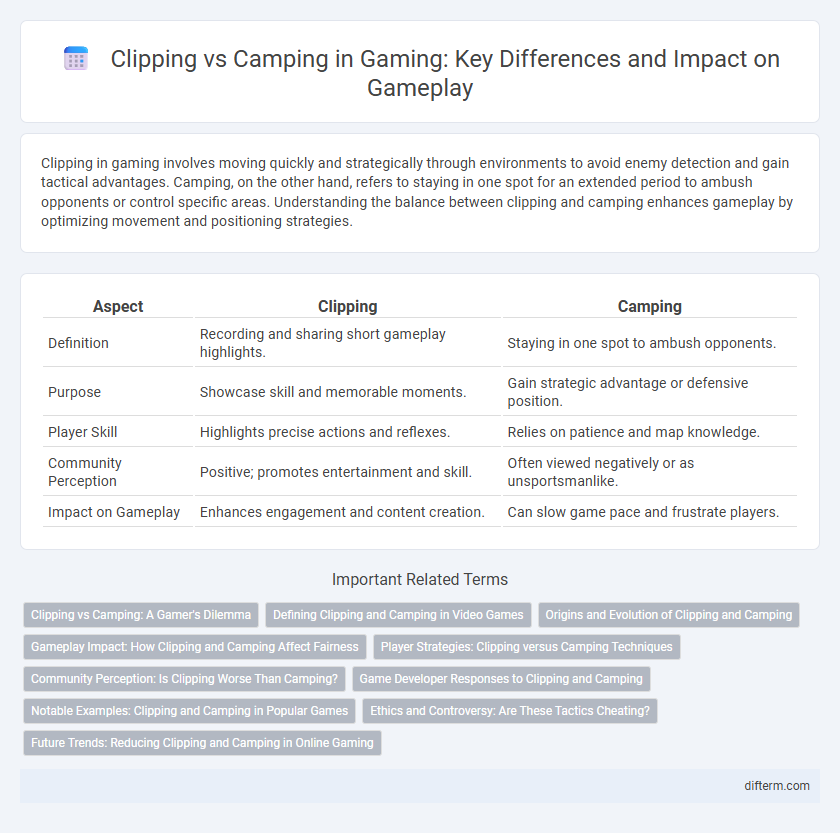Clipping in gaming involves moving quickly and strategically through environments to avoid enemy detection and gain tactical advantages. Camping, on the other hand, refers to staying in one spot for an extended period to ambush opponents or control specific areas. Understanding the balance between clipping and camping enhances gameplay by optimizing movement and positioning strategies.
Table of Comparison
| Aspect | Clipping | Camping |
|---|---|---|
| Definition | Recording and sharing short gameplay highlights. | Staying in one spot to ambush opponents. |
| Purpose | Showcase skill and memorable moments. | Gain strategic advantage or defensive position. |
| Player Skill | Highlights precise actions and reflexes. | Relies on patience and map knowledge. |
| Community Perception | Positive; promotes entertainment and skill. | Often viewed negatively or as unsportsmanlike. |
| Impact on Gameplay | Enhances engagement and content creation. | Can slow game pace and frustrate players. |
Clipping vs Camping: A Gamer's Dilemma
Clipping and camping represent two distinct strategies that influence gameplay dynamics and player engagement in first-person shooters and battle royale games. Clipping involves quickly moving through or exploiting textures and map boundaries to gain an advantage, often requiring technical skill and game knowledge, whereas camping entails staying in one spot to ambush opponents, which relies on patience and positioning. The dilemma arises as clipping can be seen as a controversial or exploitative tactic, while camping is criticized for slowing down the game's pace, forcing players to balance aggression with strategy for optimal performance.
Defining Clipping and Camping in Video Games
Clipping in video games refers to the unintended or intentional action where a player or object passes through solid boundaries or walls, often exploiting glitches to gain an unfair advantage or access hidden areas. Camping involves remaining in a fixed, concealed position, waiting to ambush opponents, which can influence gameplay dynamics by emphasizing stealth and patience over active movement. Both clipping and camping alter standard player interactions but serve different strategic purposes within multiplayer gaming environments.
Origins and Evolution of Clipping and Camping
Clipping and camping in gaming trace back to early first-person shooters like Doom and Counter-Strike, where clipping referred to the player's ability to bypass map boundaries and collide improperly with objects, while camping emerged as a tactical playstyle involving holding a fixed position for advantage. Clipping evolved with advances in game engine physics and level design, shifting from a glitch exploit to a deliberate mechanic in some titles to enable smoother navigation or hidden areas. Camping developed strategically through multiplayer shooters, becoming a controversial but integral gameplay element that influences map control and player engagement dynamics.
Gameplay Impact: How Clipping and Camping Affect Fairness
Clipping disrupts gameplay fairness by allowing players to bypass physical boundaries, creating unintended advantages and reducing map integrity. Camping impacts fairness by enabling players to exploit static positions, leading to prolonged stalemates and diminishing dynamic engagement. Both tactics undermine balanced competition by skewing player interaction and challenge levels.
Player Strategies: Clipping versus Camping Techniques
Player strategies in gaming highlight the contrast between clipping and camping techniques, where clipping involves skillful movement through complex geometry to gain positional advantages, maximizing speed and map control. Camping relies on defensive positioning, utilizing cover and ambush points to secure kills by holding strategic locations, often favoring patience and map awareness. Mastery of clipping enhances aggressive gameplay and mobility, while effective camping demands tactical observation and timing within competitive environments.
Community Perception: Is Clipping Worse Than Camping?
Clipping generates mixed reactions in the gaming community due to its reliance on exploiting glitches or mechanics for quick kills, often seen as less skillful compared to strategic play. Camping, though sometimes criticized for passive gameplay, is generally accepted as a legitimate tactic that requires patience and map knowledge. Overall, many players view clipping as more detrimental to fair play and community spirit than camping.
Game Developer Responses to Clipping and Camping
Game developers often address clipping issues by implementing collision detection algorithms and level design adjustments to prevent players from exploiting unintended map areas. Camping, which involves players staying in one spot to gain an unfair advantage, is countered through mechanics like spawn area changes, time limits, or incentives for movement to maintain balanced gameplay. Continuous updates and player feedback help developers refine these strategies to enhance fairness and game integrity.
Notable Examples: Clipping and Camping in Popular Games
Notable examples of clipping appear in games like "Fortnite," where players use clipping glitches to slide through walls and gain unfair advantages, disrupting game balance. Camping is famously seen in "Call of Duty," especially in modes like Search and Destroy, where players hide in strategic spots to ambush opponents, creating a tension-filled dynamic. Both tactics affect gameplay styles significantly, influencing player strategies and community discussions on fair play.
Ethics and Controversy: Are These Tactics Cheating?
Clipping and camping in gaming spark ongoing ethical debates, as clipping exploits game mechanics to gain unfair advantages, often considered cheating by developers and communities alike. Camping, while frequently viewed as a defensive strategy, can be controversial when it disrupts game balance or frustrates opponents excessively. Both tactics challenge fair play standards, prompting diverse opinions on their legitimacy within competitive environments.
Future Trends: Reducing Clipping and Camping in Online Gaming
Emerging AI-driven game designs prioritize dynamic environments and real-time player analytics to reduce clipping and camping behaviors, enhancing fair play and immersion. Adaptive matchmaking algorithms detect and discourage repetitive camping, promoting diverse strategies and fluid gameplay. Virtual reality integration further minimizes clipping by enforcing realistic spatial constraints, fostering more authentic player interactions in online gaming.
clipping vs camping Infographic

 difterm.com
difterm.com